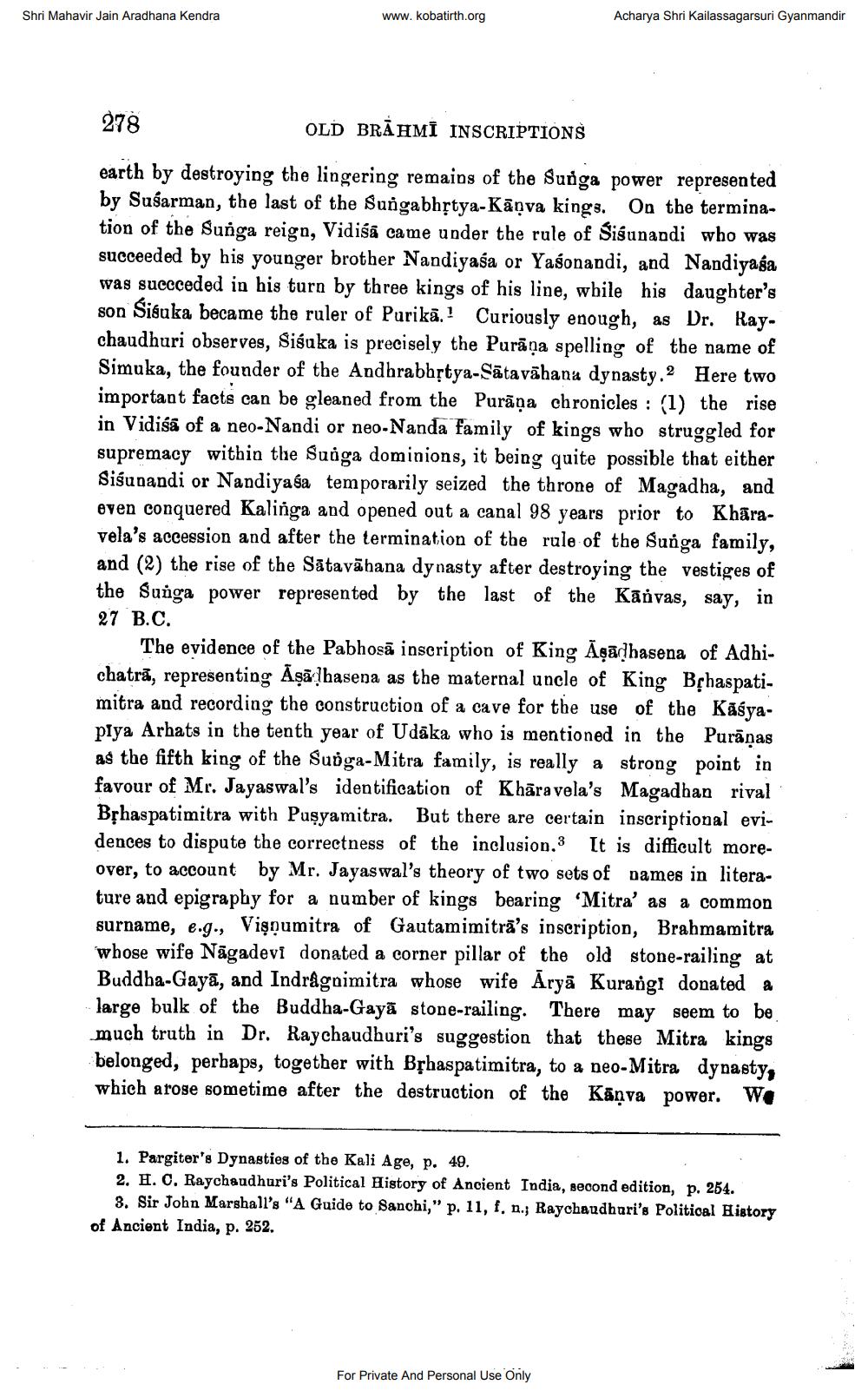________________
Shri Mahavir Jain Aradhana Kendra
www.kobatirth.org
Acharya Shri Kailassagarsuri Gyanmandir
278
OLD BRAHMI INSCRIPTIONS
earth by destroying the lingering remains of the Sunga power represented by Sušarman, the last of the Sungabhịtya-Kāņva kings. On the termination of the Sunga reign, Vidiśã came under the rule of Siśunandi who was succeeded by his younger brother Nandiyasa or Yasonandi, and Nandiyaga was succceded in his turn by three kings of his line, wbile his daughter's son Sisuka became the ruler of Purikā.! Curiously enough, as Dr. Raychaudhuri observes, Sisuka is precisely the Purāņa spelling of the name of Simuka, the founder of the Andhrabbộtya-Sātavāhana dynasty.2 Here two important facts can be gleaned from the Purāņa chronicles : (1) the rise in Vidiśā of a neo-Nandi or neo-Nanda family of kings who struggled for supremacy within the Surga dominions, it being quite possible that either Siśunandi or Nandiyaśa temporarily seized the throne of Magadha, and even conquered Kalinga and opened out a canal 98 years prior to Khāravela's accession and after the termination of the rule of the Sunga family, and (2) the rise of the Sātavāhana dynasty after destroying the vestiges of the Sunga power represented by the last of the Kārvas, say, in 27 B.C.
The evidence of the Pabhosā inscription of King Āşādhasena of Adhichatră, representing Āşā!hasena as the maternal uncle of King Bịhaspatimitra and recording the construction of a cave for the use of the Kāśyaplya Arhats in the tenth year of Udāka who is mentioned in the Parānas as the fifth king of the Suóga-Mitra family, is really a strong point in favour of Mr. Jayaswal's identification of Khāravela's Magadhan rival Bphaspatimitra with Puşyamitra. But there are certain inscriptional evidences to dispute the correctness of the inclusion. It is difficult moreover, to account by Mr. Jayaswal's theory of two sets of names in literature and epigraphy for a number of kings bearing 'Mitra' as a common surname, e.g., Vişnumitra of Gautamimitrā’s inscription, Brahmamitra whose wife Nāgadevi donated a corner pillar of the old stone-railing at Buddha-Gayā, and Indrågnimitra whose wife Āryā Kurangi donated a large bulk of the Buddha-Gayā stone-railing. There may seem to be much truth in Dr. Raychaudhuri's suggestion that these Mitra kings belonged, perbaps, together with Bșhaspatimitra, to a neo-Mitra dynasty, which arose sometime after the destruction of the Kāņva power. We
1. Pargiter's Dynasties of the Kali Age, p. 49. 2. H. C. Raychaudhuri's Political History of Ancient India, second edition, p. 254.
3. Sir John Marshall's "A Guide to Sanchi," p. 11, f. n.; Raychaudhuri's Political History of Ancient India, p. 252.
For Private And Personal Use Only




